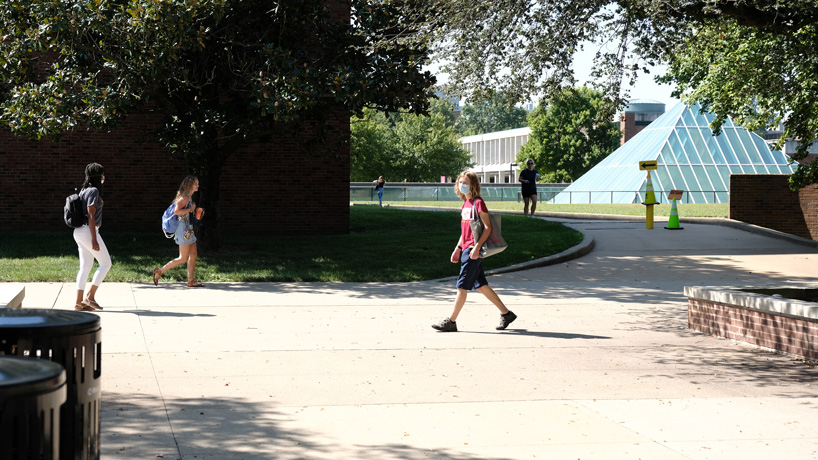
Students walk through the Quad in between classes on Monday as the fall semester began. (Photo by August Jennewein)
With the start of the fall semester, universities across the country have been challenged to decide how to best serve the academic needs of their students while also protecting the health and safety of the campus community amid the COVID-19 pandemic.
The University of Missouri–St. Louis is no different, and as Chancellor Kristin Sobolik wrote in an op-ed published by the St. Louis Post-Dispatch on Tuesday, there are no simple solutions.
“The importance and complexity of the issue cannot be overstated,” Sobolik wrote. “Our area schools and colleges enroll well beyond 300,000 children and adults — each facing a different path in returning to their studies. The course delivery format affects educational progress, home life and job status, not to mention health risks.”
Saint Louis University’s Kristi Donaldson and Andrew Diemer discussed the issues facing K-12 students, parents and district decision-makers in another Post-Dispatch op-ed last week and argued there should be more direct intervention from the state or federal governments on the decisions associated with reopening.
Sobolik does not believe the same argument holds for higher-education institutions.
“We understand that no plan is perfect — particularly given the fluid nature of this pandemic — but believe that decision-making is best left to the institutional leaders who know their students, campuses, resources and communities best,” Sobolik wrote.
She outlined the reasoned blueprint UMSL has created to begin this semester safely, with 60 percent of courses fully online and 40 percent delivered in a blended format, ready to transition to fully remote learning if public health circumstances necessitate it.
Sobolik also talked about health and safety guidelines that have been put in place, including requiring face covering in all indoor spaces as well as outdoors when it’s not possible to maintain 6-foot social distancing. UMSL has “reduced occupancy numbers for student housing, prohibited external in-person activities and are stressing virtual meetings even when employees or students are all on campus.” A full list of safety expectations can be found on the “Start Safe. Stay Safe.” website.
“Though the university has an excellent infrastructure and reputation for delivering online instruction — we know that not all students process information in the same way,” Sobolik wrote. “Many students perform better with in-person instruction and in-person support services. Also, not all courses translate easily or effectively to a virtual format — especially those set in a lab or clinic with specialized equipment.
“We are committed to give our students a great education and choices on a pathway forward. Now we need widespread cooperation to make it work.”
Sobolik concluded with a call for people to be respectful of the individuals tasked with determining guidelines and implementing them.
“Stress and anger will not make this situation better,” she wrote. “Together, we will get through this stronger.”
To read the full Post-Dispatch op-ed, click here.














